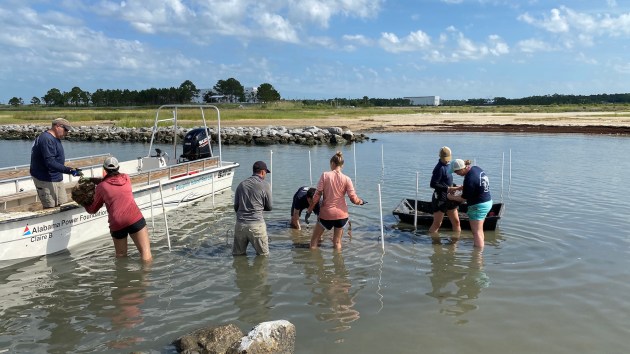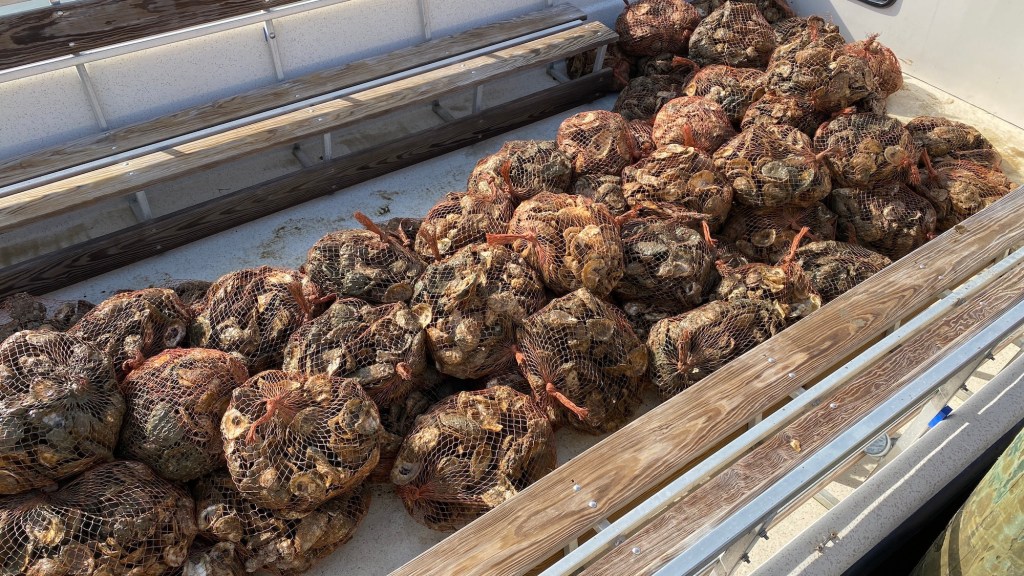The Gulf of Mexico—like many parts of the world—has lost much of its historic oyster reefs. In June 2022, a team of conservationists from The Nature Conservancy and the Dauphin Island Sea Lab constructed an oyster reef near Bayou la Batre, Alabama. (If the town sounds familiar, that may be because it’s where Forrest Gump started his career as a fictitious shrimp-boat captain.)
The project was part of a larger effort to protect the community’s eroding shoreline by installing breakwaters and restoring marshes, along with oyster reefs. But for Lee Smee, a marine scientist involved in the project, it was about studying something evolutionary too: Can you scare the oysters into being stronger and more resilient?
Q: Before you delivered the oysters to Bayou la Batre last June, you first exposed them to blue crabs. Why would you do that?
Lots of previous work has found that oysters respond to blue crabs (and other predators like oyster drills) by building heavier, stronger shells. We knew that some type of chemical from the crab triggered the oyster response, and we thought that it was likely in the urine.
Q: Why would the oysters need stronger shells?
Well, the old way to restore oysters used to be putting out some shells, and the oyster [larvae] would land on it and start to build a reef. But here [in Alabama], the natural populations have gotten so low that there are areas where there’s not enough oyster larvae in the water to get the reef going. So we grow them in a nursery and put these things out, but then they all get eaten. So, we said, can we pre-adapt them in some way?
Q: So that’s where those predator crabs, which eat oysters, come in. You said you raised the oysters in tanks with caged crabs in them. Why not just add crab urine to the tanks?
Crabs have an opening on their face near each eye that they release urine from. They actually squirt it at each other during fights. But it takes us like half of a day to get 20 milliliters of crab urine. And we need 600 or 700 milliliters for a two-month project to get them to grow. Now, if we can figure out what the molecules are [that affect the oysters], then we could make this stuff, potentially. Then it’s just, “Here’s the scary juice!” Roll this into your [oyster-growing] tank every day. But right now, we’re just not there yet.
Q: You’re working on identifying those molecules though with a couple of researchers from Georgia Tech. How is that research coming along?
We’ve identified two molecules that are involved, but they’re not the whole story. We know that because the way you do this is you expose oysters to this urine and you see the way that the oysters changed. But, there’s always variation. Some of them change a lot, some of them change a little some of them don’t really change. There’s all this natural variability. So, we give the urine samples to Georgia Tech and they analyze them. We’ve pulled two things from that and then we test them in isolation. And in isolation they kind of work but it’s not as clear as you’d think. So there’s probably some other things in there that [the oysters] are smelling, not just these two—but we’re closing in on it.
Q: That makes sense.
What’s really interesting is when we’re done we’ll be able to ask—this is an evolutionary question—but do oysters smell fear? Or do they smell specific predators?
Do fish smell like fish and crabs smell like crabs? Do blue crabs and stone crabs smell differently or are they just crabs? We don’t know. We kind of know this: If you feed [crabs] oysters, they’re scarier than if you don’t feed them something. So it could be that there’s something in the diet.

Q: You mean if you feed oysters to a blue crab, then other oysters have a stronger response to that blue crab?
It gets wilder than that. When we first did this experiment, we were feeding blue crabs oysters or clams. And we got the strongest response when blue crabs were eating clams. Well, that doesn’t really make any sense, right? And then my PhD student at the time, she said, “You know, we always feed them fresh clams. But when we’re out in the field, to save space in the cooler I go ahead and shuck the oyster and I put them on ice and then it’s like three or four days later when I actually feed them to the crab.”
So then we did a separate experiment where we [fed crabs] fresh oysters versus oysters that had been dead for several days. And [the oysters] respond more to the fresh ones. So, they can also distinguish between a blue crab that’s scavenging versus one that’s an active predator.
Q: What’s the future of the project going forward? I assume you’ll keep monitoring how well those oysters planted last June survive. What’s next?
We’re going to try it again this summer—[build a reef] adjacent to the one in Bayou la Batre. As long as we can get the manpower to do the experiments, we can just keep building reefs every summer, doing them slightly different to test something new. Over time, we’ll also have built a bunch of reef habitat.
A version of this interview ran in Nature Conservancy magazine’s summer issue. You can read more stories from that issue here including features on California’s kelp forests, a group advocating for equitable access in hunting and an effort to make the global tuna industry a bit more sustainable.




Join the Discussion